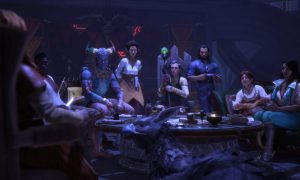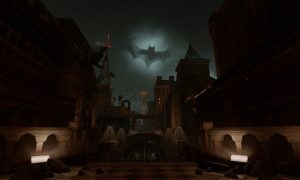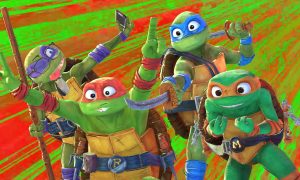 It’s a cloudy, chilly day in San Francisco — gorgeous, really — and Ted Price, CEO of Insomniac Games has spent most of it inside a dimly lit South of Market nightclub, working on the final marketing push for Fuse, their upcoming co-op shooter. It’s the day after the demo has been unleashed on Xbox 360 and PlayStation 3 to a skeptical public, and just a few weeks away from its May 28th release date. He looks visibly tired as the event begins to wind down, as we sit down to discuss Fuse, its development, and the unique set of hurdles it posed for him and his team.
It’s a cloudy, chilly day in San Francisco — gorgeous, really — and Ted Price, CEO of Insomniac Games has spent most of it inside a dimly lit South of Market nightclub, working on the final marketing push for Fuse, their upcoming co-op shooter. It’s the day after the demo has been unleashed on Xbox 360 and PlayStation 3 to a skeptical public, and just a few weeks away from its May 28th release date. He looks visibly tired as the event begins to wind down, as we sit down to discuss Fuse, its development, and the unique set of hurdles it posed for him and his team.
Understandably so, as he’s recently come off a stretch in Australia, and will be jetting off to Europe shortly after his time in San Francisco, continuing to extol the virtues of his team’s latest creation. But despite his busy schedule, and having to constantly rattle off marketing buzzwords like “lethal teamwork,” and “co-petitive,” he still maintains this amazingly genuine attitude about not only his work, but the industry as a whole. This is a man whose passion you feel in every sentence he utters. This is a man who plays Candy Box in his spare time. This is a man who loves to talk about video games.
————
The Fuse that I played at that event — the one that players will get their hands on come release day — was not the same as the game that was originally shown to the public when it was first announced. The one that players will get still maintains the same flair for the bombastic, over-the-top set pieces and weaponry that Insomniac is known for, but the reveal trailer shown a few years ago showcased a much more lighthearted tone.

Flashback to E3, 2011. EA’s press conference has revealed more than a few surprises, one of which is a partnership with none other than Insomniac Games; surprising because they’ve been a Sony-published studio for most of their existence. It was at this conference that Fuse, or as it was known then as Overstike, was unveiled to the public. What was shown was a colorful, snarky, comical take on the spy-action genre.
“That was a great promise video,” Price told me, describing the initial reveal of the trailer. “But at the same time, we were struggling to figure out how to make the weapons that you were playing with today have more punch.”
According to Price, the concept was sound, and the general idea for the game stuck around — from the beginning they knew that they wanted to create a unique four-player co-op experience, that allowed players to jet set around the globe to all sorts of exotic locales, while hunting down an alien substance.
However, something just wasn’t working with the game. None of the weapons felt right.
“We absolutely did not want a game where all four players did the same thing,” Price explained. “I think that’s, traditionally, been acceptable in co-op: you have four soldiers, and each one has a gun, and they all point at the same enemy, and that’s co-op. We knew that to raise the bar, we had to buck that trend, and that put a lot of pressure on us to deliver four weapons that could be part of a larger puzzle, and fit together well strategically.”
By fall of 2011, they knew it was time to hit the reset button, and rebuild the weapons from scratch. “We were at a spot where we had to really look inward and say, ‘What the hell are we doing? How are we going to deliver on co-op that changes the rules?’”

This was the point where the controversial tone shift from Overstrike to Fuse began to take root. The team began to figure out how they could make each of the weapons stand out, and how to make the feedback the player receives from them more impactful. “When we made the change to the weapons,” Price told me, “the main change was to make them more visceral, to give them more punch, to go more over-the-top with them, and that drove a change in tone across the entire game.”
The change wasn’t easy. Many of the team members were vocal about keeping the tone more jovial — more Ratchet than Resistance — and it took a lot of debate, a lot of give and take, to get it to the point where it’s at today.
“Ultimately, I think we ended up with a game that was much more cohesive and supports what the weapons do. However, it was important to us to retain humor in the game. And you’ve hopefully experienced some of that for yourself.”
————-
I did get a chance to experience it. Before the interview, I sat down in front of a TV with a final preview build of Fuse to play for myself. Well, myself and two other people (sadly, my group was missing a fourth, so the AI took over for the extra character). Playing through the first three levels of the game, I found myself rather impressed with what Insomniac pulled off. The story’s your typical “bad-guys-get-MacGuffin-we-gotta-stop-’em” romp, but the interplay between the four different characters, and the trademark Insomniac style is absolutely there.
Dalton is the sort of de facto leader of the group, and it’s through him that much of the game’s dry, sarcastic tone comes through. I mostly played as him, taking point and leading the squad down corridors, setting up my Magshield — a translucent, screen-encompassing, protective cover — so my teammates were protected from imminent danger. Being able to see experience point bonuses raining down the screen like popcorn just for covering them while they took out enemies from behind me feels great, and it’s impressive that Fuse is able to reward numerous playstyles — whether you’re directly assaulting your enemies, or keeping your teammates out of harm’s way, you’ll be rewarded no matter your strategy.

This synergy between Dalton’s Magshield, Izzy’s Shattergun (which freezes and lifts chains of enemies off the ground for easy shooting), Naya’s Warp Rifle (which sucks enemies into its vortex), and Jacob’s Arcshot (a sniper rifle that melts its hapless victims) was not easy to accomplish. Price explained to me that the unique balance between all four Overstrike operatives was based entirely on “trial and error,” and that the game was nearly complete before everything really came together.
“At first it wasn’t apparent. It wasn’t easy to show off, for example, a combo Arcshot/Magshield/Shattergun kill,” Price said, gesticulating as he spoke. “So we had to continue to refine the visuals, the audio, the HUD, and the enemy reactions to indicate that ‘Yes! Three of you worked together, and you did three different things to create a bigger and better result.’”
————
This refinement ultimately lead to the game’s previously mentioned shift in overall tone, and in the late summer of 2012 — over a year since its first announcement — Insomniac released the second trailer for the game, newly redubbed as Fuse. Gone was a lot of the vibrancy, the snark, the charm — and in its place was a dark, brooding, seemingly generic military-infused shooter.
Fans were not happy with this change, and were not afraid to let Insomniac know this. Forums lit up in protest to its darker, grayer color scheme and its eschewing of the campy humor originally promised in the first trailer.
Price admitted that they had perhaps gone a bit too dark. But they listened to the fans, read all the feedback, and implemented changes into their design: “We went back and looked at our environments, and said, ‘Yeah, we should course correct a bit. Let’s put more color back into the game, let’s absolutely make sure that the humor we intend comes through, and let’s continue to work on what we’ve been working on, which is delivering the best co-op experience we possibly can.’”
At the end of the day, though, they had to trust their instincts, and not let the criticisms get them down. They remained true to their core vision, while hoping that, when people finally got their hands on the demo, they’d finally be able to see what they were trying to accomplish.
The gamble seems to have paid off, as initial impressions of the demo seem largely positive:
Nice work @insomniacgames. I just played the Fuse demo. I can see it being a lot of fun playing co-op with friends. — R.S. Hunter (@rshunter88) May 13, 2013
Hearing this a lot. RT @gorgeouscborges: @andrew_reiner I was vaguely interested in Fuse before I played the demo. Now I’m completely sold. — Andrew Reiner (@Andrew_Reiner) May 11, 2013
I played the demo for the new game that I’ve looked at a while ago #Fuse and wow it looks pretty good! Might pre-order or something — Ember Jay (@JustCallMeEmber) May 11, 2013
Having played the preview build myself, I’ve definitely noticed that, while it may not be as comedic as a game like Ratchet and Clank, it doesn’t have the bleak, gritty feel of a game like Resistance, and it certainly doesn’t play anything like the dime-a-dozen military shooters already on the market. To drive this point home: the boss of the second level is a giant Russian guy with glowing eyes and lasers shooting out of his hands. Fuse is a distinctly Insomniac-developed title, and it’s something that you’ll feel from the word “go.”
Price understands that there are people who will probably just hate the game no matter what anyone has to say about it, whether due to its tonal shift or any perceived publisher pressures (an unfounded accusation, as Insomniac retains all property rights to Fuse). He remains optimistic about its reception, however: “I feel confident that there are enough objective gamers out there that any game has the possibility of changing minds.”
———-
After sinking my teeth into three rather lengthy campaign chapters (and a quick break for lunch — more so for my eyes than my stomach), we shifted gears and hopped into Echelon mode: a wave-based mode that Price described with the particularly buzzword-y “co-petitive” moniker. During my conversation, I mentioned that it was akin to Gears of War 3’s “Horde” mode, and he was quick to correct my comparison.
“It’s a lot like Smash TV,” he told me, and he’s right. Each round of Echelon mode pits four players against an increasingly difficult group of enemies, with each round featuring a new objective — protect this point, go grab this weapon cache, destroy this mech, etc. (in fact, there’s only one objective that requires you to protect an area, another distinction from “Horde” mode that Price pointed out to me) — so players have to work together to make it all the way through twelve harrowing rounds. But there’s another element at play here that forces players to answer some personal psychological questions about how they interact with their teammates.

Randomly, when enemies fall under the might of the Overstrike team’s super-powered weaponry, giant sacks of cash and hulking stacks of gold bars burst forth, enticing players to give up on actually helping their friends and make a mad dash towards the newly-splayed bounty of loot. “We see that the gamer’s tendency is to just run for it,” he says, describing what makes Echelon stand out from the other co-op modes on the market, “go for it, because that’s your cash, you’re collecting it, you’re not sharing it with your buddies. It’s fun to see how people react to that.”
I’m not one to shy away from the fact that I, too, played into this mentality perfectly. My partners would be downed, crawling toward me for a much-needed revive, and instead of taking the few seconds to bring them back into the fray, I ran right past them to grab the shiny lucre that’s rightfully mine — if only because I saw it first.
“It was a really fun social experiment,” he explained, “because we as players felt exactly the same way. It’s always that tug-of-war between doing what’s best for the team, and doing what’s best for yourself, and so it creates a neat tension that doesn’t exist in other modes.”
One thing I did notice is a complete lack of competitive modes in the game. Sure, you’re “competing” to grab loot, but you’re still working in concert with your companions toward a common goal. According to Price, this was deliberate.
“We experimented with it, originally. And we realized that there are a lot of deathmatch competitive modes, and one in particular seems to suck up about 90% of people’s attention,” Price said, obliquely referring to Call of Duty’s gargantuan presence in the competitive multiplayer mindshare. “Our goal, when we thought hard about it, was that we’d be much better off allowing people to exercise the co-operative skills they’ve learned in the story-driven campaign, and have fun achieving really tough challenges together in a more arcade-y mode, and thus Echelon was born.”
————
One of the things that EA helped bring to the table was the ability for Price to fly all over the world to evangelize his team’s latest game. He loves the opportunity to host events like this, where industry members of all stripes can come and check out his studio’s games. Sony, despite all of its marketing muscle, only ever did massive world tours with Insomniac twice — once for Ratchet and Clank in 2002, and once, in a smaller way, for Resistance: Fall of Man in 2005. EA, he says, has allowed them to get the game in the hands of journalists around the globe, to show them exactly what makes Fuse so special. “We like that personal touch at Insomniac,” he told me, “because we want to connect with fans, journalists, anybody that’s connected to the business, and explain why we’re excited about the games we make.”

EA was also able to provide them with the necessary tools to publish their first multi-platform title — tools like Xbox 360 development kits. “We couldn’t work with Sony,” he explains, with a slightly sarcastic tone in his voice, “because we intended the game to be on Xbox 360, and Sony’s not publishing for the Xbox 360.”
He described development on the Xbox 360 as “surprisingly straightforward,” with his “core” team — the team responsible for building all of the development tech for his studios — creating a new engine specifically for implementing efficient multiplatform development. Price is very happy with the results: “I think both sets of fans will be very happy, because there’s, in my opinion, no difference between the two [versions of Fuse].”
————
There’s been a massive cloud hanging over the gaming industry for the last few months. Studios are either laying off entire teams or shuttering completely. It’s a dark time to work in game design, and yet, Insomniac seems to have stayed above all of that, and continues to add people to its staff, rather than subtract — in fact, as I left the event, I noticed on my Twitter feed that Insomniac was looking to hire several new employees.
How are they able to continue to grow in these tumultuous times? Price attributes that to a few things: “We’re small, we’re flexible, and we’re independent, and those three aspects help us adjust quickly if something goes wrong.” He compared his studio to other larger conglomerates that would have more difficulty in adapting to a constantly changing market, whereas Insomniac has the flexibility to react to those changes.
“An example of this,” Price explained, “is, last year, releasing [Outernauts], our first game on Facebook and Kongregate, but then realizing that social games are trending downward, so let’s move into mobile. We may be late to the party in terms of mobile developers, but from a traditional console developer’s perspective, we’re probably one of the few that’s making the jump.”
He realizes that there’s no one-size-fits-all solution that he could implement to save them from some unforeseen doom that may lurk around the corner. But the solution to his company’s success might be more simple than you’d think: “Maybe at the core of it all is that we truly have a passion for making games. From top to bottom, we love games. We love playing games, and we love the opportunity that we have to create new stuff all the time. That more than anything allows us to get through the tough times.”

————
Despite the rather volatile nature of the games industry, Price is incredibly bullish about its future. He spoke about the potential of the PlayStation 4 from a consumer’s perspective, and how Sony’s effort to make independent development and console publishing easier than ever before speaks well for the future of the industry.
I asked him if he’s been playing anything lately — if anything had grabbed his attention away from promoting Fuse.
“Funny, the last new game I started was yesterday — I started Candy Box. Do you know Candy Box?” Price asked. I laughed, told him I did, and asked him how far he’d gotten into it.
“I’ve gotten to the — well, that’s a hard question to answer, because when I left the office yesterday, I had 10 thousand lollipops, and maybe 50 thousand candies, but I only had a diamond sword, and… a couple of boots, and I hadn’t gotten any armor yet, and I’m still trying to get through the castle quest where you keep getting teleported back to the beginning. So, I’ve got my berzerk spells, but I used them all, [laughs] so I think I’m hosed.”
It’s so refreshing to talk to someone with such a long and storied history within the industry, who is so enmeshed in console and triple-A development, and yet, still speaks about a goofy little ASCII-based game with such pie-eyed wonderment. And that’s, ultimately, what makes Insomniac Games such a special company.
“I love triple-A console games,” Price said. “I love co-op games with my kids, I love indie games like Candy Box and other stuff that I’ll find on mobile or PSN or XBLA. I mean, for me, it’s a wonderful time to be a gamer.”
I couldn’t have said it better myself.
I've been gaming since my dad made the bad decision of buying me a Nintendo when I was four years old. Every day I'd find myself with my face glued to a TV screen, punching away at buttons, getting furious with Bowser, Dr. Wily, and those freakin' birds in Ninja Gaiden. Since then I have failed to get my parents to play any board game with me, I sold my full copy of Earthbound with box and guide for $300 to some dude in Austria for rent money, and I still believe in Nintendo even after all these years.

See below for our list of partners and affiliates:

























